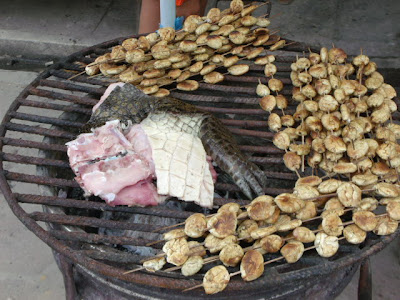The weekend we were in Iquitos -the last weekend in June- was a 3-day weekend honor of the feasts of St. Peter and St. John. St. Peter being the patron of fishermen, there was a parade in the port district of Nanay and its streets were crowded with makeshift kitchens and eateries selling the local fare -mostly grilled chicken and fish, regional specialties such as tacacho (roasted green plantains, pounded to mush and formed into a ball), cecina (salted and smoked pork or peccary meat), and juanes (turmeric-laced rice, with chicken or pork, cooked in banana or bijao leaves), as well as some less pedestrian items such as turtle and cayman.
 |
| Cayman meat, with a type of roasted seeds |
 |
| Bottom: Roasted plantains; Right: Tacacho, with bits of cecina |
Another favorite snack in the region -and one much missed by at least one iquiteno cab driver in Lima- is suri.
Suri are the grubs of a beetle, Rhynchophorus palmarum, which lays its eggs inside palm trunks. There, the larvae burrow, feed, and grow fat for 50 to 70 days before pupating. In parts of Latin America that rely on the production of palm oil or coconut products for a living, the grubs are considered a pest. In Peru's jungle communities, however, they are a treat.
I had mine roasted.
Upon biting into a suri one is immediately struck by the fattiness of the grubs. It is not surprising that they came to be viewed as a treat in a land where, for millenia, people have had to take advantage of every precious source of calories they could get their hands on.
The taste was somewhat reminiscent of the fatty trimmings off of a cooked pork roast. To be fair, I expect most people are turned off by the fatty, oily mouth feel before they even get to the flavour. It was not an altogether unpleasant flavour, but I won't claim to have liked it.
After eating the guts and juices, I was left with the tough skin. It was a bit like chewing on a plastic bag. I just spat it out.


No comments:
Post a Comment